Essential for getting started with ffmpeg
Preface
I recently wanted to play with video watermarking, so I found the ffmpeg script, and then started playing with this tool.
Here are just simple operations, there are more tricks to play, and other functions are waiting for you to discover.
1. Installation
If you want to use it, you must install it first. Next, Kaka will take you step by step to achieve it. Install.
The installation environment is centos7 for linux.
Download address: wget https://johnvansickle.com/ffmpeg/builds/ffmpeg-git-amd64-static.tar.xz
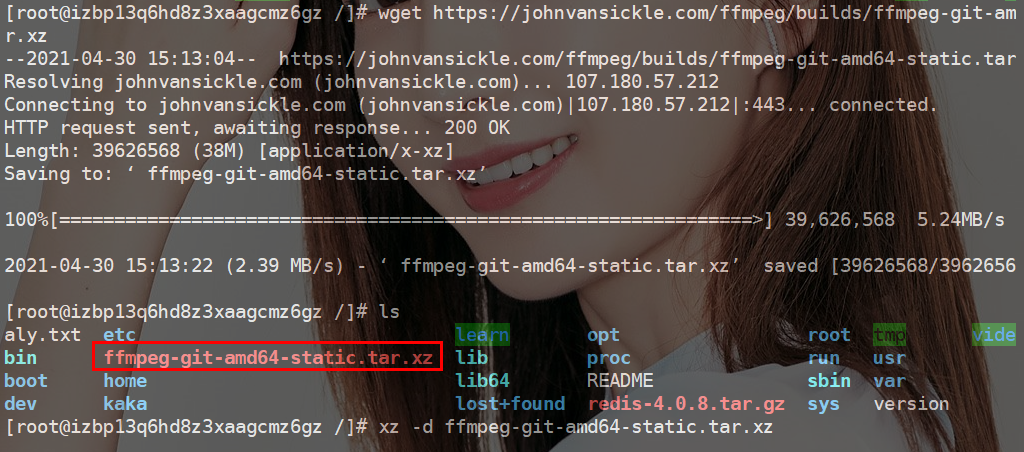
Figure 1-1 is the compressed package after downloading.
You can see that this compressed package is different from the usually used tar, and the suffix is xz.
Execution: xz -d ffmpeg-git-amd64-static.tar.xz Perform the first step on the downloaded file.

Figure 1-2 is the file after executing the above command. At this time, the file suffix is only tar.
Then use tar to further decompress the file.

Figure 1-3 is the decompressed file.
After fmpeg is downloaded, it is started.
Go to the file you just decompressed, and then execute ./ffmpeg.
If you can see the information below, it means the installation has been successful.

2. Let ffmpeg be used globally
In fact, it is to create a soft link. Links on Linux are divided into soft and hard links. As for the detailed explanation, please check the relevant information yourself!
First enter the bin directory: cd usr/bin
Then execute the following two commands, as shown in Figure Essential for getting started with ffmpeg, click here to facilitate the decompression of the files A name change was made.

3. Everything is ready, start watermarking the video
Execute command: ffmpeg -i test.mp4 -vf "drawtext=fontfile=/SIMHEI.TTF: text='Kaka Chat':x=100:y=10: fontsize=48:fontcolor=red:shadowy=2" new.mp4
Parameter description
i is followed by the original video -vf is followed by the font position text Is the watermark name x horizontal axis coordinate y vertical axis coordinate fontsize is the font Size fontcolor is the text color new.mp4 is the new output file
Start executing this command happily. When you click Enter to execute, you will be asked to enter y\n.
Just enter y directly.
Then you will be disappointed to see such an interface, as shown below
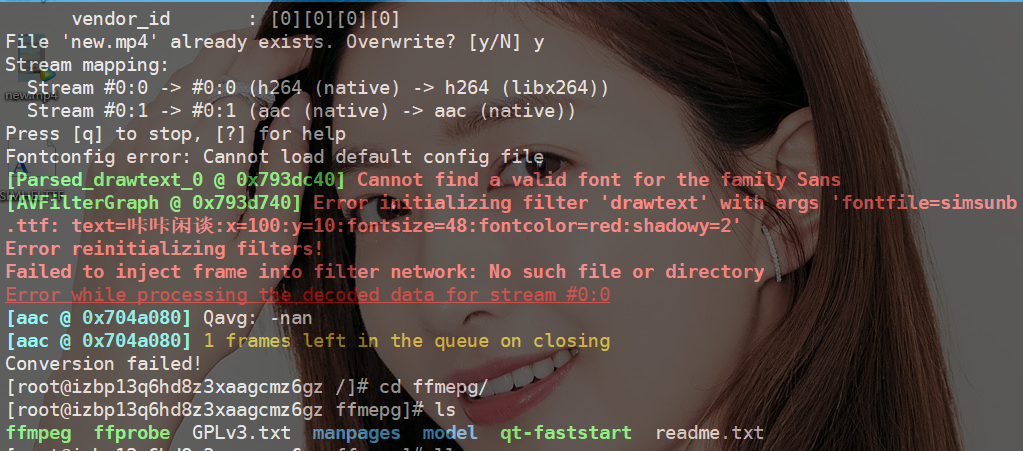
According to the error message, you can get I know the font cannot be found.
Since the font cannot be found, this is not very easy to deal with. Just open a window computer and you can choose from a variety of fonts.
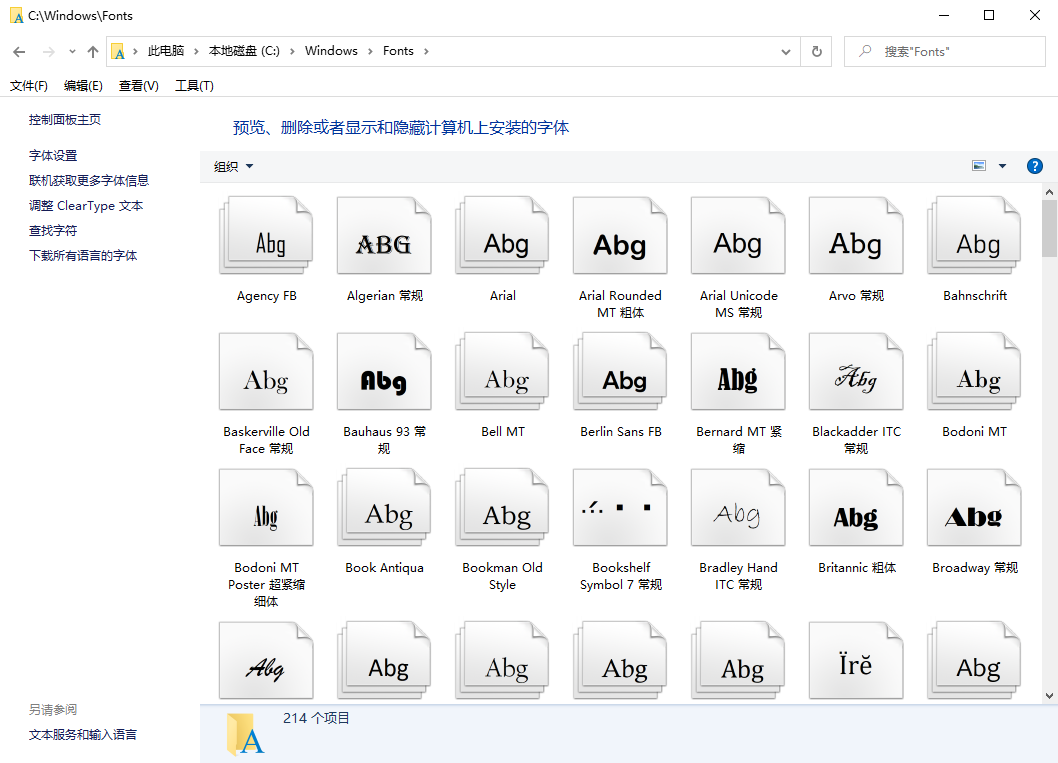
Just copy the font you need and then transfer it to the linux server.

Then execute the command again.
You will then be able to see the data, which means that the text watermark has been printed successfully.
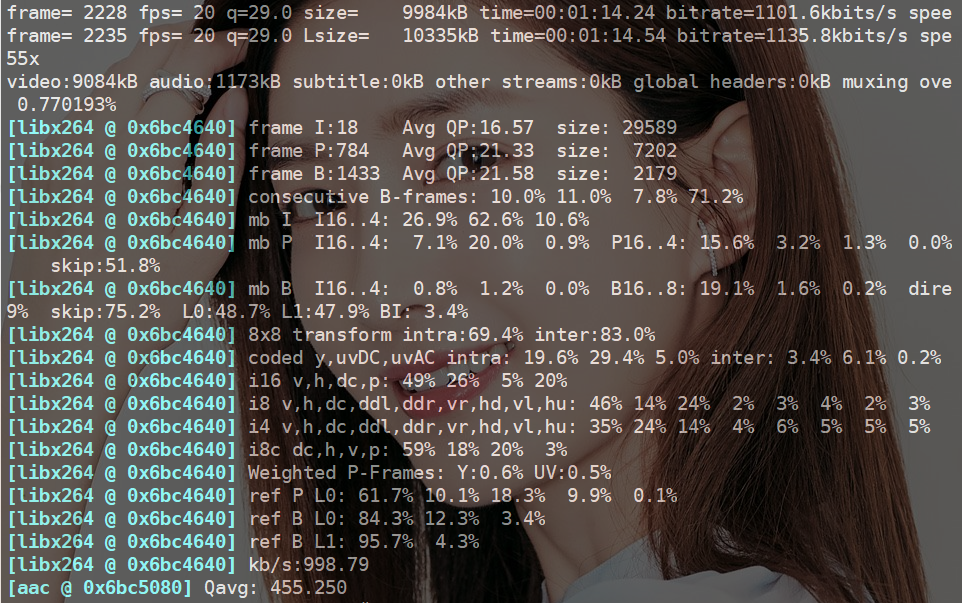
If you look at the renderings, you can see that the four words Kaka Chat have been typed into the video.
Have you ever wondered why watermarked videos are so bad?
Actually, this has nothing to do with ffmpeg. This is compressed when recording gif.

Since text watermarks are so successful, the same is true for picture watermarks. Next, let’s take a look at what picture watermarks should be. Do.
4. Add image watermark to the video
Execute the command: ffmpeg -i test.mp4 - vf "movie=mark.png[watermark];[in][watermark] overlay=10:10[out]" new.mp4
Parameter Description
-i is the original video name mark.png is the watermark image location overlay is the image location new.mp4 is the name of the new video
It is much easier to use image watermark than text watermark. You don’t need to consider whether the font exists, you only need to have a watermark image.
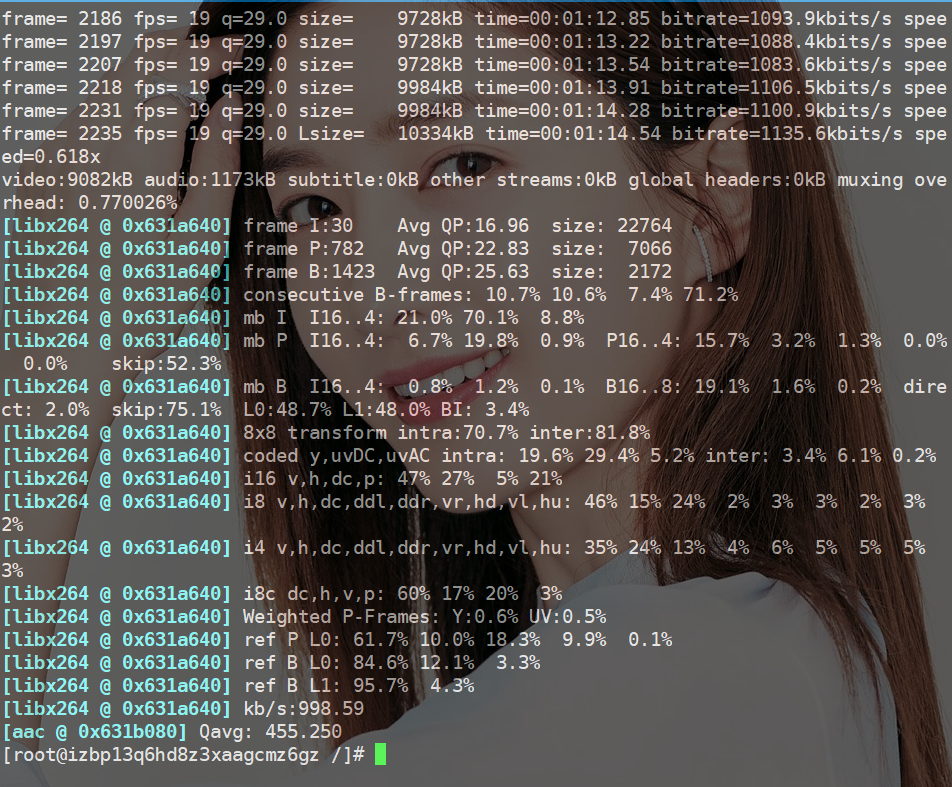
The picture above is the effect after the picture watermark is successfully set.
Let’s take a look at the effect!
The picture of 51 in the upper left corner is the watermark picture set by Kaka.
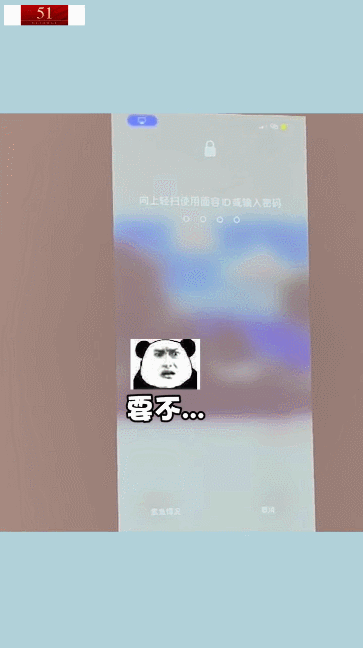
After looking at the above two operations, it seems very simple, but in fact ffmpeg is very complicated, and there is so much content that it will make you collapse.
But we don’t need to understand everything, as long as it can fulfill our needs.
For example, current video websites basically play in m3u8 mode, so ffmpeg can also convert video files in mp4 format into m3u8 format.
If you are interested, you can give it a try. I won’t go into details here.
Persistence in learning, persistence in writing, and persistence in sharing are the beliefs that Kaka has always adhered to since its beginning. I hope that Kaka’s articles on the huge Internet can bring you a little bit of help. I’m Kaka, see you next time.
The above is the detailed content of Essential for getting started with ffmpeg. For more information, please follow other related articles on the PHP Chinese website!

Hot AI Tools

Undresser.AI Undress
AI-powered app for creating realistic nude photos

AI Clothes Remover
Online AI tool for removing clothes from photos.

Undress AI Tool
Undress images for free

Clothoff.io
AI clothes remover

AI Hentai Generator
Generate AI Hentai for free.

Hot Article

Hot Tools

Notepad++7.3.1
Easy-to-use and free code editor

SublimeText3 Chinese version
Chinese version, very easy to use

Zend Studio 13.0.1
Powerful PHP integrated development environment

Dreamweaver CS6
Visual web development tools

SublimeText3 Mac version
God-level code editing software (SublimeText3)

Hot Topics
 Golang and FFmpeg: How to achieve audio mixing and separation
Sep 27, 2023 pm 02:24 PM
Golang and FFmpeg: How to achieve audio mixing and separation
Sep 27, 2023 pm 02:24 PM
Golang vs. FFmpeg: How to implement audio mixing and separation, specific code examples required Summary: Audio processing is an essential part of many multimedia applications. In Golang, we can use the FFmpeg library to achieve audio mixing and separation. This article will introduce how to use Golang to call the FFmpeg library to achieve audio mixing and separation, and provide specific code examples. By studying this article, readers will learn how to use Golang and FFmpeg to implement audio processing
 Practice of video splicing using Golang and FFmpeg
Sep 28, 2023 am 08:37 AM
Practice of video splicing using Golang and FFmpeg
Sep 28, 2023 am 08:37 AM
Practical introduction to video splicing using Golang and FFmpeg: In daily life, we often encounter situations where we need to merge multiple video files into one, such as splicing multiple recorded videos into a complete video file. To achieve this goal, this article will introduce how to use Golang and FFmpeg libraries to implement the video splicing process, and provide specific code examples. 1. What are Golang and FFmpeg? Golang (Go language) is an open source programming language developed by
 Golang and FFmpeg: How to implement audio synthesis and segmentation
Sep 27, 2023 pm 10:52 PM
Golang and FFmpeg: How to implement audio synthesis and segmentation
Sep 27, 2023 pm 10:52 PM
Golang and FFmpeg: How to implement audio synthesis and segmentation, specific code examples are required Summary: This article will introduce how to use Golang and FFmpeg libraries to implement audio synthesis and segmentation. We will use some specific code examples to help readers understand better. Introduction: With the continuous development of audio processing technology, audio synthesis and segmentation have become common functional requirements in daily life and work. As a fast, efficient and easy to write and maintain programming language, Golang, coupled with FFmpeg
 How to install PHP FFmpeg extension on server?
Mar 28, 2024 pm 02:39 PM
How to install PHP FFmpeg extension on server?
Mar 28, 2024 pm 02:39 PM
How to install PHPFFmpeg extension on server? Installing the PHPFFmpeg extension on the server can help us process audio and video files in PHP projects and implement functions such as encoding, decoding, editing, and processing of audio and video files. This article will introduce how to install the PHPFFmpeg extension on the server, as well as specific code examples. First, we need to ensure that PHP and FFmpeg are installed on the server. If FFmpeg is not installed, you can follow the steps below to install FFmpe
 The practice of using Golang and FFmpeg to achieve video de-flickering
Sep 27, 2023 pm 04:46 PM
The practice of using Golang and FFmpeg to achieve video de-flickering
Sep 27, 2023 pm 04:46 PM
A practical overview of using Golang and FFmpeg to achieve video de-flickering: Video flickering is a challenge often encountered in video processing. When the frame rate of the recorded video does not match the lighting frequency, it may cause flickering in the video. This article will introduce how to use Golang and FFmpeg libraries to achieve video de-flickering, and provide specific code examples. Steps: Install the FFmpeg library: First, we need to install the FFmpeg library in the Golang development environment. able to pass
 Golang and FFmpeg: How to implement audio format conversion and compression
Sep 28, 2023 pm 07:13 PM
Golang and FFmpeg: How to implement audio format conversion and compression
Sep 28, 2023 pm 07:13 PM
Golang and FFmpeg: How to implement audio format conversion and compression, specific code examples are needed. Introduction: In audio file processing, sometimes you encounter the need to convert audio formats or compress audio file sizes. As a powerful programming language, Golang, combined with FFmpeg, a popular audio and video processing tool, can achieve fast and efficient audio format conversion and compression. This article will introduce how to use Golang and FFmpeg to achieve audio format conversion and compression, and give specific code examples.
 Golang and FFmpeg: Technology for real-time video stream analysis and recognition
Sep 27, 2023 pm 02:31 PM
Golang and FFmpeg: Technology for real-time video stream analysis and recognition
Sep 27, 2023 pm 02:31 PM
Golang and FFmpeg: Technology to implement real-time video stream analysis and recognition, requiring specific code examples Introduction: In today's digital and intelligent era, video technology is increasingly used. Among them, the analysis and recognition of real-time video streams play an important role in security monitoring, intelligent transportation, face recognition and other fields. This article will introduce how to use the technology combining Golang and FFmpeg to realize the analysis and identification of real-time video streams, and provide specific code examples. 1. Introduction to Golang Golang is a
 PHP FFmpeg extension installation guide: easy-to-follow tutorial
Mar 28, 2024 pm 02:17 PM
PHP FFmpeg extension installation guide: easy-to-follow tutorial
Mar 28, 2024 pm 02:17 PM
PHPFFmpeg Extension Installation Guide: Simple and easy-to-understand tutorial In the process of website development, sometimes we need to process various multimedia files, such as audio, video, etc. FFmpeg is a powerful multimedia processing tool that can process audio, video and other formats, and supports various transcoding, cutting and other operations. The PHPFFmpeg extension is an extension library that calls FFmpeg functions in PHP. It can be used to process multimedia files easily. Below we will introduce PHPF in detail






